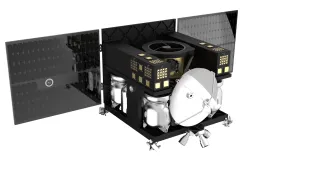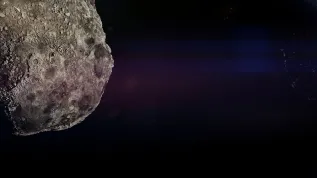
Even the biggest pieces of space debris can be caught in nets and then safely burned in the atmosphere. The first test nets for cleaning up the cosmos have been developed by Poles, who have already checked their performance in virtual reality and in the state of weightlessness.
There are already thousands of pieces of space debris in space. "They are generated, for example, by collisions of objects in space. The collision of Russian satellite with the Iridium constellation satellite resulted in more than three thousand pieces of space junk. Part of space debris are parts of rocket carrying objects to Earth orbit" - said Dr. Karol Seweryn from the Space Research Centre PAS. Space debris also includes already defunct satellites, and even items left in space by astronauts: a glove lost by astronaut Ed White, and actual garbage bags from the Soviet station Mir.
These useless, orbiting objects present a risk for space exploration instruments and space missions. "Even small space debris - 5 cm across - fly at a speed of several kilometres per second. That is much faster than the speed of a fired rifle bullet, which means that they can easily damage other working satellites. The effects are very dangerous and expensive: for example GPS disruptions, loss of meteorological data, lack of remote sensing data" - explained Dr. Seweryn.
One of the biggest pieces of space debris is the Envisat satellite, defunct since 2009. The European Space Agency plans to get rid of this troublesome satellites in 2022 using an innovative method: catch it in a net connected with a rope to a special satellite, acting as a "garbage truck". After the Envisat, the time would come for other pieces of space junk. In the first part of the implementation of this plan, Polish companies will help the ESA\'s professionals. Tender winners, a Polish-Italian consortium, have already prepared test nets for simulations in virtual reality and during parabolic flight.
"Such a space mission costs millions of dollars and has to be successful at first shot. There is no room for experimentation. Therefore, in order to be able to use the net in space, we need a tool that will first check the system on Earth. Here, however - also due to gravity - it can not be fully tested. Which is why we use computer models, simulations" - told PAP Wojciech Gołębiowski, technical director at SKA Polska, one of the companies involved in the project.
Polish engineers have prepared a simulator, virtual environment in which such net can be designed, including the thickness of each thread, the shape of the mesh and the weights attached to the corners of the net. Later in the virtual world, researchers can shoot the net and track its flight, look at the way individual strands stretch and the weights catch the satellite. "Making such a tool is a big challenge, because it must be accurate and fast. After a virtual shot we analyse the way our net has wrapped. If it wrapped up wrong several times, we correct it and shoot again. In virtual reality, we can repeat such experiments repeatedly until we get the optimal shape of the net" - described Gołębiowski.
However, for the simulator to start serious work, Polish engineers had to prove that the net shot in the experiment would fly and wrap around the satellite, just like in the simulation. "We had to demonstrate that the virtual world and the real world corresponded. We had to conduct an experiment in zero gravity, which is possible during parabolic flight. As a result of manoeuvres if an aircraft that first climbs and then falls in a controlled way, passengers experience about 20 seconds of 0G" - said Gołębiowski.
Poles performed the flight in the Canadian National Research Council institute, which organizes parabolic flights. They prepared net launcher prototypes and a small model of the Envisat satellite, and their Italian colleagues - 25 nets. In February, onboard Falcon 20 aircraft they conducted 20 successful experiments. The nets caught the satellite so well they had to be cut with a knife before shooting another net.
The net used in the experiment resembles those used to catch fish or wild animals, except that it is very colourful. But it is not about the aesthetic appearance of the net. The colours are very useful during the experiment. "We want to know the exact trajectory of each knot, so that we can model in the computer the path each of them travels. Since the set of colours around each knot is unique, we have a code that tells us: it is a knot in the second column, third row. This allows the algorithms to identify the knot. It is very important when the net is wrapped around the satellite, and is very tangled" - emphasised Wojciech Gołębiowski.
In the real task of catching Envisat, the cosmic garbage truck will have approach it at the appropriate distance, observe its movement, and launch the net at the right moment. The net will catch the space debris, connecting it with a rope to the space garbage truck. The system will circle the Earth, gradually lowering its orbit until it burns up in the atmosphere.
The space debris catching mission does not end with Envisat. Other objects will be captured the same way. "The net can be designed individually for each target. We can take the geometry of the selected space debris, put into our simulator and adjust the net" - noted Gołębiowski.
ESA will announce tenders for the implementation of the next stages of the space debris catching project. Poles have an opportunity to participate in the next parts, for example prepare the nets that will not only simulate the manoeuvre, but actually catch the satellite, or test the net using rocket probe. The budget of the project, which the company SKA Polska carries out in cooperation with OptiNav from Słupsk and an Italian partner, is nearly 2 million euros.
Space net technology is one of three that the ESA may use to destroy space debris in the future. "In addition to the use of nets, the ESA considers a manipulator mounted onboard a special satellite, which could capture space debris or entire satellites. There is a third idea to destroy debris from Earth using laser station. However, this causes a lot of discussion on how to do that with thousands of aircrafts flying in the sky. The implementation of each of these ideas requires time and money" - said Dr. Seweryn.
PAP - Science and Scholarship in Poland, Ewelina Krajczyńska
ekr/ mrt/
tr. RL













